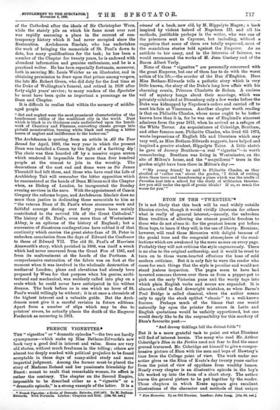ETON IN THE "TWENTIES."* Jr is not likely that this
book will be read widely outside Etonian circles, though it would vividly illustrate for others what is really of general interest,—namely, the unbroken Eton tradition of allowing the utmost possible freedom to those who do not abuse it: for the greatest lesson put before Eton boys, to learn if they will, is the use of liberty. Etonians, however, will read these Memories with delight because of the genial tone and the congenial atmosphere of the recol- lections which are awakened by the mere names on every page. Probably they will not criticise the style ungenerously. There is no clue to the original authorship, and it would be cruel to turn on to these warm-hearted effusions the hose of cold modern criticism. But it is only fair to warn the reader who cares for such things that the style is peculiar and would not stand jealous inspection. The pages seem to have had inverted commas thrown over them as from a pepper-pot to pick out the early Victorian puns and the wordy tags into which plain English verbs and nouns are expanded. It is almost a relief to find downright mistakes, as when Barrio's Pool Bridge is called classical, where the author means only to apply the stock epithet " classic " to a well-known feature. Perhaps much of the blame that one would naturally lay upon the printer for errors in Latin and English quotations would be unfairly apportioned, but one would dearly like to fix the responsibility for this mockery of Eton's favourite poet :—
"And drowsy tickling-6 lull the distant folds " !
But it is a, more grateful task to point out what Etonians will find of interest herein. The many who read Mr. Arthur Coleridge's Eton in the Forties need not fear to find the same ground traversed. Mr. Coleridge set himself to give a compre- hensive picture of Eton with the men and boys of Hawtrey's time from the College point of view. The work under our notice gives us the Eton of Keate's day twenty years earlier from the point of view of oppidans from wealthy homes. Nearly every chapter is an illustrative episode in the boy's life worked up into the form of a short story. The author leaves the general picture to be put together by the reader. Those chapters in which Keate appears give excellent illustrations of the character and methods of that unique
• Eton Memories. By an Old Etonian. London; John Long. [10e. 6d. nat.]
Head. The atmosphere of high spirits and devotion to the school created by the book makes it very pleasant reading for old Etonians.































































 Previous page
Previous page